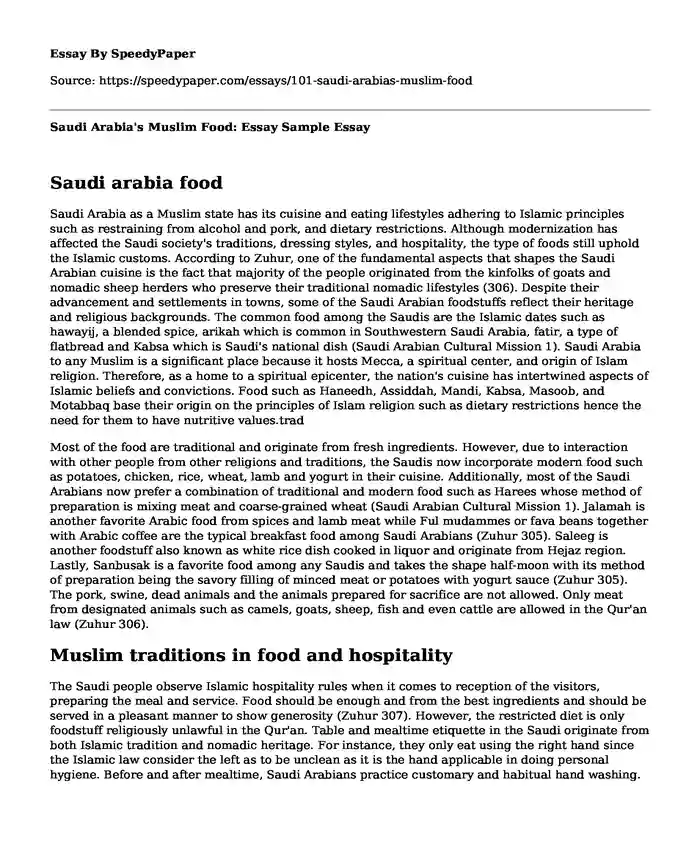Saudi arabia food
Saudi Arabia as a Muslim state has its cuisine and eating lifestyles adhering to Islamic principles such as restraining from alcohol and pork, and dietary restrictions. Although modernization has affected the Saudi society's traditions, dressing styles, and hospitality, the type of foods still uphold the Islamic customs. According to Zuhur, one of the fundamental aspects that shapes the Saudi Arabian cuisine is the fact that majority of the people originated from the kinfolks of goats and nomadic sheep herders who preserve their traditional nomadic lifestyles (306). Despite their advancement and settlements in towns, some of the Saudi Arabian foodstuffs reflect their heritage and religious backgrounds. The common food among the Saudis are the Islamic dates such as hawayij, a blended spice, arikah which is common in Southwestern Saudi Arabia, fatir, a type of flatbread and Kabsa which is Saudi's national dish (Saudi Arabian Cultural Mission 1). Saudi Arabia to any Muslim is a significant place because it hosts Mecca, a spiritual center, and origin of Islam religion. Therefore, as a home to a spiritual epicenter, the nation's cuisine has intertwined aspects of Islamic beliefs and convictions. Food such as Haneedh, Assiddah, Mandi, Kabsa, Masoob, and Motabbaq base their origin on the principles of Islam religion such as dietary restrictions hence the need for them to have nutritive values.trad
Most of the food are traditional and originate from fresh ingredients. However, due to interaction with other people from other religions and traditions, the Saudis now incorporate modern food such as potatoes, chicken, rice, wheat, lamb and yogurt in their cuisine. Additionally, most of the Saudi Arabians now prefer a combination of traditional and modern food such as Harees whose method of preparation is mixing meat and coarse-grained wheat (Saudi Arabian Cultural Mission 1). Jalamah is another favorite Arabic food from spices and lamb meat while Ful mudammes or fava beans together with Arabic coffee are the typical breakfast food among Saudi Arabians (Zuhur 305). Saleeg is another foodstuff also known as white rice dish cooked in liquor and originate from Hejaz region. Lastly, Sanbusak is a favorite food among any Saudis and takes the shape half-moon with its method of preparation being the savory filling of minced meat or potatoes with yogurt sauce (Zuhur 305). The pork, swine, dead animals and the animals prepared for sacrifice are not allowed. Only meat from designated animals such as camels, goats, sheep, fish and even cattle are allowed in the Qur'an law (Zuhur 306).
Muslim traditions in food and hospitality
The Saudi people observe Islamic hospitality rules when it comes to reception of the visitors, preparing the meal and service. Food should be enough and from the best ingredients and should be served in a pleasant manner to show generosity (Zuhur 307). However, the restricted diet is only foodstuff religiously unlawful in the Qur'an. Table and mealtime etiquette in the Saudi originate from both Islamic tradition and nomadic heritage. For instance, they only eat using the right hand since the Islamic law consider the left as to be unclean as it is the hand applicable in doing personal hygiene. Before and after mealtime, Saudi Arabians practice customary and habitual hand washing.
In summary, the Saudi Arabian nationals still consume their spiritual and traditional food with unique preservation of Islamic eating lifestyles and dietary practices. Although their cooking methods have slightly changed due to modernization and shifts in lifestyles, Saudi Arabian food and nutrition still reflect their religious customs as governed by the laws in the Qur'an.
Works Cited
Saudi Arabian Cultural Mission. History of Food in Saudi Arabia. Saudi: Saudi Arabian Cultural Mission (SACM), 2013. Print.
Zuhur, Sherifa. Saudi Arabia. Santa Barbara: ABC-CLIO, 2011. Print.
Cite this page
Saudi Arabia's Muslim Food: Essay Sample. (2018, May 24). Retrieved from https://speedypaper.com/essays/101-saudi-arabias-muslim-food
Request Removal
If you are the original author of this essay and no longer wish to have it published on the SpeedyPaper website, please click below to request its removal:
- Essay Example: Intimate Dependence and Its Risks in Neoliberal Japan
- Samoan Culture, Free Essay Example
- History Essay Sample on How China Rebelled Against Japan during World War 2
- Free Essay on the "Antigone" Play
- Free Essay: Reformational View of Vocation
- Essay Sample on The Hawaiian Case
- Experiences that Affected my Personality. Free Essay
Popular categories





